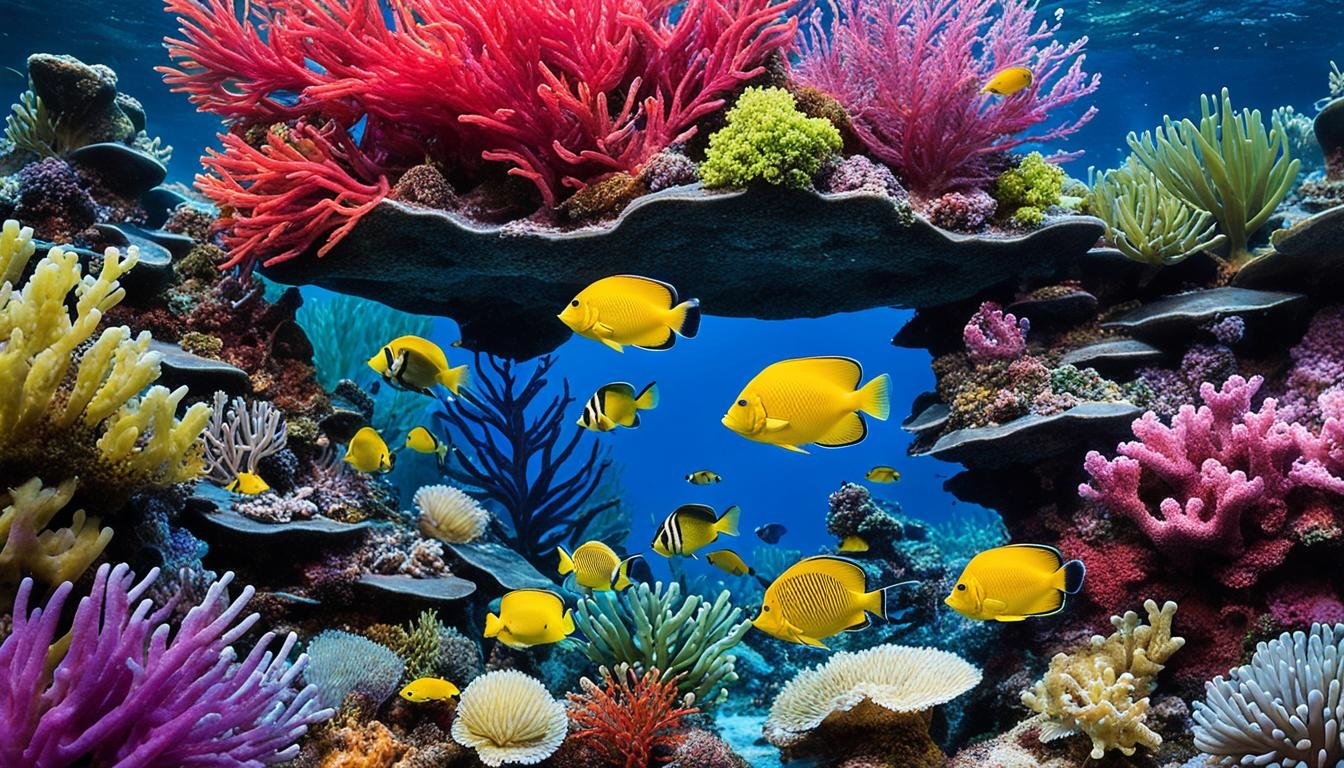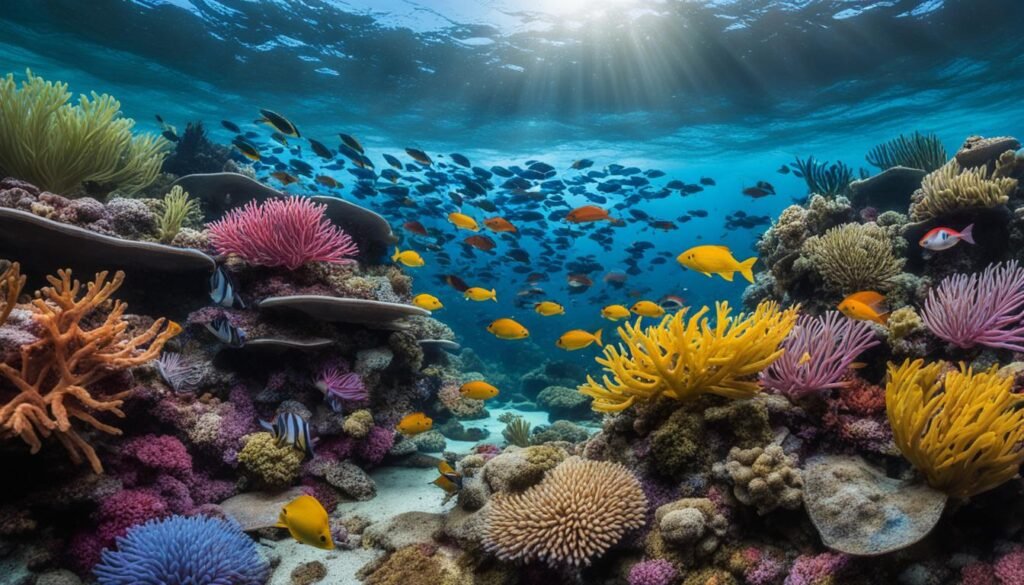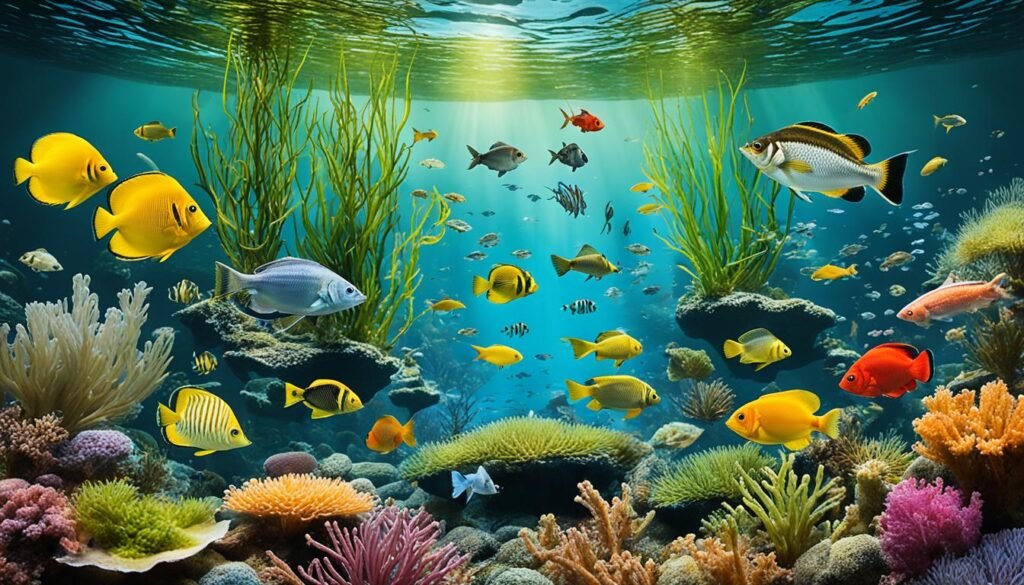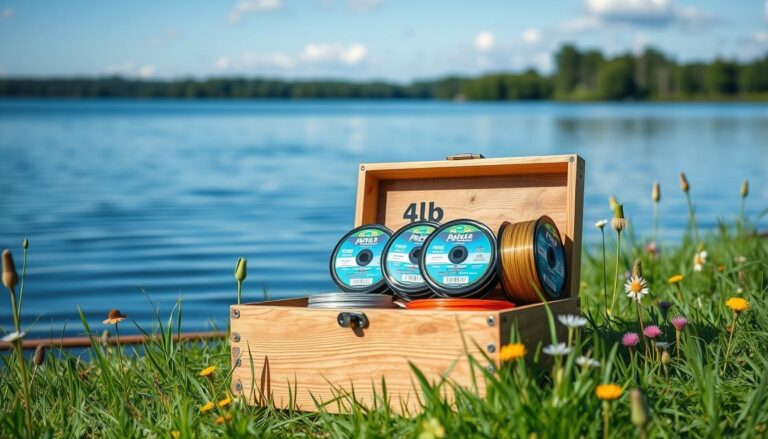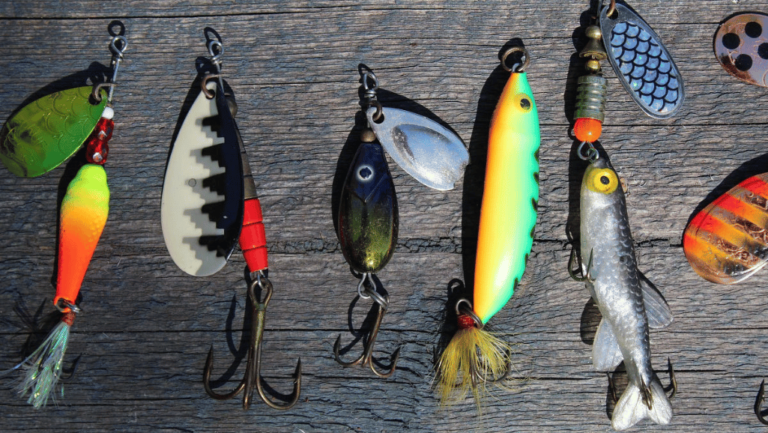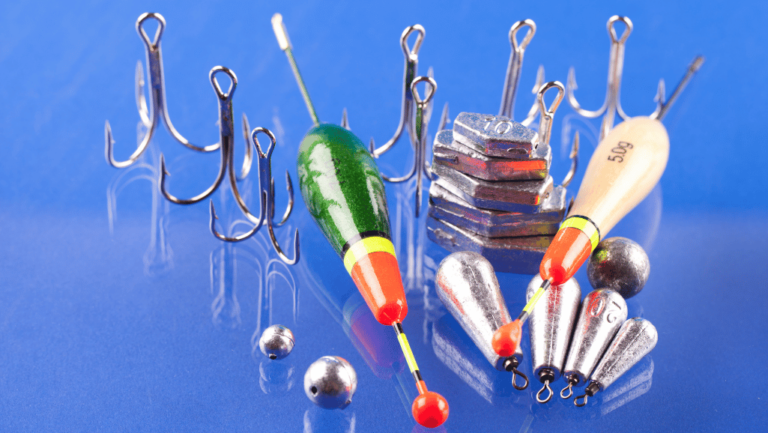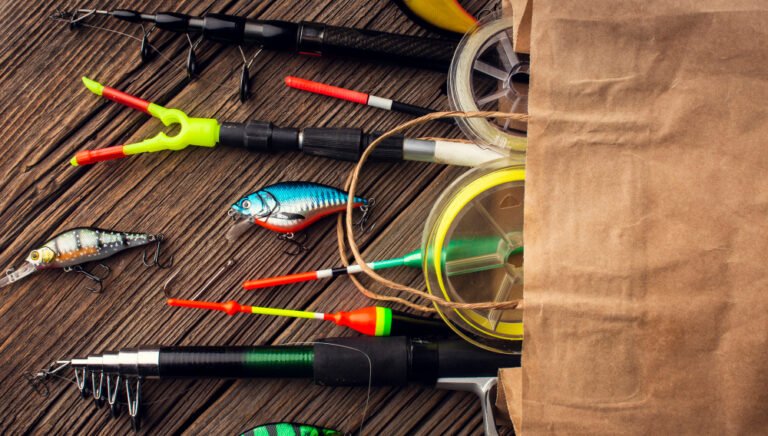Exploring fish in aquatic ecosystems is fascinating. It covers a wide range of species found in different places. From peaceful lakes to vast oceans, fish have found ways to live and thrive. This diversity is crucial for the balance of nature. To protect these environments, we must understand and cherish the many fish types.
Key Takeaways
- Aquatic ecosystems host a wide variety of fish species.
- Fish adaptations play a crucial role in their survival and ecological balance.
- Conserving fish biodiversity is vital for healthy aquatic ecosystems.
- Both freshwater and marine fish species exhibit remarkable diversity.
- Research and conservation efforts are key to sustaining fish populations.
Introduction to Aquatic Fish Diversity
Exploring the aquatic life of our planet shows a rich variety of species diversity. Around 250 new types of fish are found every year. This makes a total number of about 34,800 known fish species by February 2022.
These different fish types live in both the sea and the freshwaters. It shows how these creatures can live in many underwater ecosystems.
There is a lot of variety in where fish live. There are calm freshwater lakes and vast salty oceans. The freshwaters in Neotropics, for example, have over 5,600 species. This makes up 10% of all vertebrates on Earth.
Most fish belong to the Teleost class, with almost 30,000 different species. This is about 96% of all fish species alive today.
Underwater ecosystems are very varied. Saltwater areas are huge, covering 361 million km². They hold 58% of fish species. Freshwater areas are smaller, at 1.5 million km², but they have 41% of fish species.
Amazingly, fish can live in very tough places. For example, the Tibetan stone loach lives in very high places, over 5,200 meters above sea level. The Abyssobrotula galatheae lives very deep, at 8,372 meters down. On the other hand, the pygmy goby only lives for about 59 days.
| Country | Fish Production Contribution |
|---|---|
| India | 7% of global fish production |
| China | First-largest fish producer |
| Indonesia | Third-largest fish producer |
India is the third-largest fish producer worldwide and the second-largest in fish farming. It gives about 7% of the world’s fish. India is very rich in fish diversity, with over 10% of the global variety.
In 2017-18, India produced about 12.60 million metric tonnes of fish. Nearly 70% of this came from inland waters. This shows how important freshwater places are for fish.
Types of Fish in Freshwater Ecosystems
Freshwater has a lot of different fish that live there. Each fish is made to do well in its own water home. They play important roles in nature, have smart ways to survive, and need our help to stay around.
Common Freshwater Fish Species
The U.S. has fish like largemouth bass, bluegill, and catfish in many water places. In Florida, largemouth bass and bluegill are very important for the environment. Fish such as salmon travel a lot, showing amazing life journeys.
Adaptations to Freshwater Habitats
Fish in freshwater have different ways to live there. Bass and catfish can handle changes in salt levels well. Salmon can move between fresh and salt water to lay eggs.
Conservation Challenges in Freshwater Ecosystems
Freshwater places are in danger from human actions. Many fish are at risk from losing their homes, pollution, and new species. In North America, 40% of freshwater fish are in trouble because of us.
Today, a third of the world’s freshwater fish might disappear forever. Their numbers went down by a lot between 1970 and 2014. We need to protect their homes urgently.
| Region | Conservation Status |
|---|---|
| North America | 40% of freshwater fish endangered |
| Global | 33% at risk of extinction |
| Global (Population decline 1970-2014) | 83% average decline |
| Yangtze Basin, China | Many species have drastically declined due to habitat degradation |
Saltwater Fish Species: A Marine Marvel
Our oceans are a grand stage for various saltwater fish species. They add to the beautiful tapestry of marine biodiversity. From the bright colors of coral reefs to the deep, dark ocean, these fish come in all shapes, sizes, and colors.
Common Marine Fish Varieties
Marine fish are known for their big sizes and bright colors. Take the Clownfish, for example; it can grow up to 4.3 inches (11 cm) long. On the other hand, the Humphead Wrasse can reach up to an incredible 6 feet long. It can also weigh up to 400 pounds. There are also Regal Blue Tangs that are about 12 inches (30 cm) long. Plus, there are the amazing Leafy Sea Dragons, which can be up to 13.8 inches (35 cm) long.
| Species | Typical Size | Habitats |
|---|---|---|
| Clownfish | Up to 4.3 inches (11 cm) | Coral reefs |
| Humphead Wrasse | Up to 6 feet | Coral reefs |
| Regal Blue Tangs | 12 inches (30 cm) | Coral reefs |
| Leafy Sea Dragons | 13.8 inches (35 cm) | Seagrass beds |
| Lionfish | 11.8-17.7 inches (30-45 cm) | Warm marine waters |
Unique Adaptations to Saltwater Environments
Adaptations in marine fish are truly amazing. For instance, the Mandarinfish, about 2.8 inches long, has bright colors that help it blend in with corals. The Emperor Angelfish, on the other hand, grows up to 16 inches. It has a color pattern that warns its predators and helps it communicate with other fish.
Fish have developed special traits to survive in their habitats. They have streamlined bodies and unique gills for moving and breathing in water. For species like the Ornate Butterfly Fish, which grows to about eight inches, their adaptations are specially designed for their environments.
It’s vital to protect the marine homes of these amazing fish species. Threats like overfishing and climate change are real. It takes hard work to keep our oceans healthy and full of life.
Popular Fish Species for Aquariums
Being an aquarium enthusiast is a lot of fun. You get to choose and look after popular fish species that are colorful and interesting. They make any tank lively and interesting. But, it’s very important to know what these aquarium fish types need to be happy.
Types of Aquarium Fish
People who love aquariums often pick fish like Guppies, Neon Tetras, and Zebrafish. These popular fish species are eye-catching. They are also easy to take care of. This makes them great for both beginners and those who have been keeping fish for a while.
| Fish Species | Adult Size | Life Span |
|---|---|---|
| Mickey Mouse Platy | 1 1/2 to 2 inches (3 1/2 to 5 centimeters) | 5 years |
| Guppy | 2 inches (5 centimeters) | 3 to 5 years |
| Zebrafish | 2 inches (5 centimeters) | 5 years |
| Neon Tetra | 1 1/2 inches (4 centimeters) | 5 years |
| White Cloud Mountain Minnow | 1 1/2 inches (4 centimeters) | 3 to 5 years |
| Harlequin Rasbora | 1 3/4 inches (4 1/2 centimeters) | 6 years |
| Serpae Tetra | 1 3/4 inches (4 1/2 centimeters) | 5 years |
| Panda Corydoras | 2 inches (5 centimeters) | 10 years |
| Glowlight Tetra | 1 1/2 inches (4 centimeters) | 5 years |
| Pea Puffer | 1 to 1 1/2 inches (3 to 4 centimeters) | 4 years |
| Tiger Barb | 3 inches (7 centimeters) | 6 years |
| Swordtail | 3 to 4 inches (7 to 10 centimeters) | 3 to 5 years |
| German Blue Ram | 2 to 3 inches (5 to 7 centimeters) | 3 to 5 years |
Care Requirements for Popular Species
Looking after these fish well makes aquariums a great place for them. For example, Guppies and Mickey Mouse Platys are good for newbies because they’re tough. They like water that’s between 72-82°F and has a pH of 6.8-7.8. Neon Tetras, on the other hand, need soft and a bit acidic water that’s between 70-81°F.
It’s also important to keep the tank clean and check the water often. This helps keep the fish in top shape. The goal is to make a living space that feels just like their natural home. When done right, keeping fish brings both beauty and a sense of achievement to enthusiasts.
Exotic Fish Species: A Glimpse into the Unusual
Exotic fish species are the stars of the aquatic world, showing off rare and amazing fish. They have captivated both scientists and hobbyists. The love for keeping exotic freshwater fish grew in the West thanks to better aquarium tech. This interest started in the 1800s and continued into the 1900s.
Aquarium keeping went from just outdoor ponds to sophisticated indoor setups. This change was huge for these unique fish.
Exotic freshwater fish like Discus, Bettas, and African Cichlids bring a lot to the aquarium hobby. Having a great aquarium means you need to focus on the right tank size, clean water, and the perfect living space for your fish. Lighting, feeding, and keeping up with the tank are also key.
| Exotic Fish Species | Care Requirements |
|---|---|
| Discus | Require warm water, a balanced diet, and frequent water changes. |
| Bettas | Need small tanks, stable water temperature, and specialized betta food. |
| African Cichlids | High pH and hard water, diverse diet, and ample hiding spots. |
| Angelfish | Prefer tall tanks, peaceful tank mates, and varied diet. |
| Arowanas | Large tanks, meaty diet, and strong filtration system. |
Feeding exotic fish right is key to their health. This includes a mix of foods, the right amount, and paying attention to what each fish needs. Breeding them means understanding the fish’s natural behavior and creating the perfect environment for them to reproduce. This helps in efforts to protect these fish and reminds people about the importance of taking care of aquatic life properly.
Fish Types in Manu’s Biodiversity Hotspot
The Manu biodiversity hotspot, located in the Peruvian Amazon, is full of unique fish species. It’s a key area for conservation. The region’s fish play important roles in the Manu River’s ecosystems.
Unique Species in Manu River
The Manu River shines with various fish. Each fish, from arapaimas to piranhas, is vital. They keep the ecosystem in balance and show us the story of life’s evolution in water.
Ecological Roles and Interactions
It’s crucial to understand how fish species in Manu affect each other. These interactions support the health of their living spaces. This includes eating other fish (predation), living together (symbiosis), and competing for resources.
From big predators to small plant-eaters, they make a complex system. This system keeps the ecosystem working well.
Conservation Efforts and Challenges
Protecting the Amazon faces big challenges like deforestation and pollution. Activities by people, like overfishing, threaten the fish. But, Peru is working hard to solve these problems.
They focus on saving natural spaces by involving local communities and using smart ways. This helps keep the amazing fish diversity in Manu alive.
Visiting Manu can also help. Tours there, like the Manu Amazon Tours and the Manu Reserved Zone Tours, teach people about conservation. They also bring money that can support these efforts.
Adaptations and Behaviors of Different Fish
Fish have many adaptations for their surroundings. These include things they are born with, what they’ve learned, and what they sense in their environment. They perceive the world through their senses like sight, smell, hearing, touch, and taste. They also use a special organ to detect water movements.
Migratory Patterns and Breeding Behaviors
Salmon, for example, travel long distances to breed. They move from fresh to saltwater and back. This journey is key to keeping the species widely spread, helping them survive.
Fish have interesting ways to reproduce. Some do dances or use scents to attract a mate. Others, like sardines, form groups for safety and breeding. This teamwork lowers the chance of being eaten and makes it easier to have babies.
Survival Strategies: Camouflage and Defense Mechanisms
Fish use clever methods to avoid being eaten. Some can disguise themselves to look like their surroundings. The stonefish looks like a rock, keeping it safe from enemies.
Other fish have active ways to protect themselves. Electric eels, for instance, can stun attackers with electricity. These types of defense, whether hiding or fighting, help fish survive in the wild.
Learning about these adaptations shows us how smart and capable fish are. It is interesting to see how they have evolved to live in many different places.
Ecological Roles of Fish in Aquatic Ecosystems
Fish keep the balance and health of water homes in check. They do this through various key activities. So, they are vital for the health of these areas.
Predatory Fish and Ecosystem Balance
Big fish, like sharks and others that eat fish, are very important. They help control the number of fish they eat. This keeps the mix of fish in check, which is good for the water world. An example is when Limnothrissa miodon was added to Lake Kariba. It ate a lot of plankton, showing how it affected life in the lake. In Lake Victoria, adding Lates species nearly wiped out some other fish. This shows how important they are in the big scheme of things.
Herbivorous Fish and Plant Management
Fish that eat plants help keep the water world’s greenery in balance. This is crucial for reefs and seagrass. In areas with these helpful fish, seagrass grows much faster. In fact, it grows four times more compared to areas without them.
Nutrient Cycling and Habitat Creation
Fish are major players in moving nutrients around in water. They add nutrients that help other plants and creatures grow. This helps the whole ecosystem work better. Around big reefs, the effect can reach up to three meters. This boosts how productive the ecosystem is.
What’s more, different fish provide different levels of nutrients. This shows why having many types of fish is good. Fish also make the water more oxygen-rich. They create living spaces for a lot of sea creatures. So, the process they are part of is key for keeping water places thriving.
Future Trends in Aquatic Fish Research
Aquatic fish research is about to make big leaps, thanks to marine biology innovations and aquatic research developments. These new steps will help us understand life in the water better and make sure fishing is done sustainably. New tech like artificial intelligence (AI), the Internet of Things (IoT), and machine vision are key. They allow for better tracking fish and keeping an eye on populations, which helps in fisheries conservation technology.
In 2018, the world made about 179 million tons of fish, and 82 million of those came from fish farming. More and more people are eating fish every year. From 1961 to 2017, the rate that fish consumption went up was faster than the growth of the world’s population. This shows that fish is becoming very important as a food source.
But, there are challenges for the fish farming industry. The people working in fish farming are getting older, and it’s hard to find new workers. The COVID-19 pandemic made this worse by limiting travel. The way that fish farming can harm water and its living things through overfishing and pollution is also a big worry.
Even with these challenges, there are new hopeful trends in fish farming. Things like farms that are better for the environment, big industrial sites, and smart fish farms are all growing in use. They make not only better, but also help protect the environment.
To sum up, we’re at an exciting time in fish research because of new technologies and a focus on the future. Working together using the latest methods, researchers are ready to address big issues and embrace new chances. This is how we’ll build a strong and diverse water world for the future.
Conclusion
Fish come in many shapes and sizes, from small glassfish to giant whale sharks. This shows how well they adapt to water habitats. Keeping these ecosystems healthy is very important. But, things like overfishing, destroying habitats, and pollution are big problems for fish. We must work to save them not just for nature but for people who need fish to eat.
Protecting fish is vital, as they keep the environment balanced and provide food. Aquaculture, or fish farming, is trying to meet the growing demand for fish. But, it has issues like hurting the environment and disease risks. We need smart fishing and farming methods to lower these risks and keep the seas alive. Watching and making sure people follow fishing rules is key to saving our fish for the future.
Fish are important for more than just food. Some, like certain types of fish, help keep coral reefs healthy by eating algae. Others tell us if water is clean or not by how they react to pollution and temperature changes. Protecting fish like Alaskan pollock and cod means using careful fishing methods and strict rules. This helps keep the sea ecosystem in good shape.
In conclusion, the world of fish is vast and essential for the planet’s health. They add to the beauty and balance of the oceans, no matter where they live. By caring for fish and their homes, we keep the underwater world thriving for the future.

